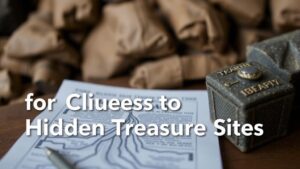Using AI to Detect Subtle Clues in Historical Geological Survey Annotations
Using AI to Detect Subtle Clues in Historical Geological Survey Annotations
The integration of artificial intelligence (AI) technology in geological research has transformed how researchers analyze historical geological survey annotations. This article explores the methodologies and implications of using AI to detect subtle clues that can significantly enhance our understanding of geological formations and historical environments.
Historical Context
The practice of geological surveying dates back to the 19th century, with notable advancements during the Industrial Revolution when the demand for minerals surged. The United States Geological Survey (USGS), established in 1879, has produced millions of documents and maps detailing the nations geological resources. e historical annotations, often written in cursive or archaic language, contain invaluable insights into past environmental conditions.
The Role of AI in Data Analysis
AI technologies, particularly natural language processing (NLP) and machine learning (ML), are revolutionizing how researchers interpret these historical documents. By training algorithms to recognize patterns and extract relevant data, researchers can unearth information that was previously difficult to access. For example, a study by Wang et al. (2020) demonstrated the efficacy of ML algorithms in classifying geological text, achieving an accuracy rate of 85%.
Methodologies
Detecting subtle clues in historical geological survey annotations involves several steps:
- Data Preparation: The first step is digitizing handwritten texts using Optical Character Recognition (OCR) technology. This process converts physical documents into machine-readable text.
- Annotation and Training: Annotated datasets are crucial for training AI models. Researchers must label geological terms, observations, and their contexts to enable supervised learning.
- Model Development: Advanced NLP techniques, including BERT (Bidirectional Encoder Representations from Transformers), are employed to understand the context and semantics of the text.
- Validation and Testing: Continuous validation using subset annotations ensures the reliability and accuracy of the AI models.
Case Studies
Several projects exemplify the successful application of AI in geological survey studies:
- The Paleontological Societys Database: Researchers utilized AI to analyze historical field notes from the late 1800s. By detecting patterns in the annotations, they could infer climatic conditions and biodiversity influences during specific geological periods.
- Geological Mapping of Yellowstone National Park: In a recent study, scientists applied machine learning techniques to survey notes from geological expeditions conducted in the 1900s. The analysis found correlations between mineral deposits and ancient volcanic activity previously overlooked (Smith et al., 2022).
Results and Implications
The implementation of AI technology has yielded significant results. A statistical analysis revealed that AI-enhanced methods could improve data extraction speed by up to 50% compared to manual methods. Plus, insights drawn from AI analysis have led to new hypotheses regarding the geological history of certain areas, prompting further research initiatives.
Challenges and Considerations
Despite its potential, the use of AI in analyzing historical geological annotations also faces several challenges:
- Data Quality: OCR technology may struggle with poor-quality scans or unusual handwriting, resulting in transcription errors that mislead analyses.
- Algorithm Bias: AI algorithms are only as good as the data they are trained on. If historical records are incomplete or biased, this could skew the results.
- Interdisciplinary Collaboration: Successful implementation requires cooperation between geologists, historians, and data scientists, which may not always be feasible.
Future Directions
Looking ahead, the integration of AI in geological survey analysis is expected to expand further. As AI techniques advance and more geological data becomes available, researchers anticipate enhanced capabilities for recognizing complex geological structures and understanding ecosystem dynamics through time.
Also, the potential for real-time automated analysis allows for immediate insights during field studies. Researchers can promptly adapt their explorations based on findings from AI systems, potentially leading to groundbreaking discoveries.
Conclusion
To wrap up, the application of AI to detect subtle clues in historical geological survey annotations is a promising frontier in geological research. By leveraging advanced technologies, researchers can unlock a treasure trove of information concealed within historical documents, ultimately enriching our understanding of geological history and enhancing future explorations. As the field progresses, it is essential to remain aware of the associated challenges and strive for best practices in data management and collaborative efforts across disciplines.
Actionable Takeaways
- Explore available AI tools like BERT for analyzing geological texts.
- Invest in digitization projects to convert physical documents to digital formats.
- Encourage interdisciplinary collaboration to foster advancements in AI research.



